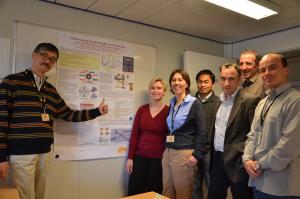Go ahead for ITER's gas injection system
23 Feb 2012
-
Sabina Griffith
ITER Director-General Osamu Motojima and Luo Delong, Director of the Chinese Domestic Agency, shaking hands after the signing ceremony.
This Monday, ITER Director-General Osamu Motojima and the Head of the Chinese Domestic Agency Luo Delong signed the Procurement Agreement for the gas injection system that—in some respects—is the mechanical respirator of the ITER machine.
The gas injection system will provide the "initial fill" of the vacuum chamber prior to plasma initiation; it will puff gas into the chamber during the ramp-up phase; it will enable the control of plasma density during the flattop of plasma burn; and it will protect the divertor targets from discharges by injecting impurity gases. It also provide a system for the emergency shutdown of the machine.
The gas injection system will permit the injection of different gases simultaneously: three hydrogenic species; helium; and impurity gases (argon, neon and nitrogen). The required throughput of the system will be 400 Pa m3/ sec at peak—far beyond the fueling capabilities of existing fusion machines, according to So Maruyama, leader of ITER's Fuelling & Wall Conditioning Section. "The real challenge of designing the gas injection system, however, is the tritium compatibility required of all the components and the high magnetic fields that these components will have to face."
The home-team celebrating the signature with Section Leader So Maruyama: at right Ina Backbier, Sylvie Ward, Yu Yang, Michael O'Connor, Thierry Jourdan and Gabor Kiss.
Gas arriving from the Tritium Plant will be distributed through a 200-metre-long manifold system that will supply a total of ten gas valve boxes of which four are distributed over the upper port level of the vacuum chamber. Six more gas valve boxes are placed in the lower port level of the chamber near the divertor. Gas injected at the upper port level moves along pipes that end between the blanket modules, where one- to two metre-long slots allow the gas to be uniformly distributed in the plasma chamber.
Extra care must be taken in the region near the divertor, where the ultra-hot plasma is likely to hit the divertor targets on a localized surface with extremely high heat-fluxes. Infrared cameras will be installed to monitor this area closely. In the case of an event, the lower port-level gas valve boxes can then be triggered to inject impurity gas or a gas mixture which will irradiate the heat.



